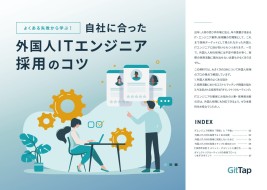[2021] Five IT engineering job categories in demand in the market
IT engineer is a general term for technicians who deal with IT (Information Technology), and positions such as “systems engineer” and “programmer” fall under this category.Since there are many different types of IT engineers, many people who want to become IT engineers may not know what to aim for. If you are thinking of becoming an IT engineer, you should first know the “five high-demand job categories” in the IT market, which we will introduce today.After all, if you want to pursue a career as an IT engineer, it is important that you learn the latest programming languages and get exposed to the latest technologies. You should also think about your future position, such as whether you want to be a systems engineer or a programmer.In this article, we will focus on the five job categories of IT engineers that are in demand in the market today.Five IT high-demand engineering jobsBelow we explain the five IT engineering job categories that are currently in high demand by companies. This table was created in consultation with GTalent recruiters and was originally designed to reflect the latest needs and trends among companies.◆ Five IT high-demand engineering jobsWe have ranked the IT engineer job categories from 1 to 5 based on company demand, but basically the demand for all categories is very high. The average annual salary for IT engineers is 4.5 million yen. Data Scientists (ranked 3rd) and DevOps Engineers (ranked 5th) have the highest average annual salary among IT engineers, and since they require a high level of expertise, there is not much talent on the market.In contrast, the annual salaries of Web Application Engineers (ranked 1st) and Mobile Application Engineers (ranked 2nd) are closer to the average, as there are relatively many workers available due to high demand from companies.Below is a detailed explanation of each job category.#1: Web Application EngineerA web application engineer is an engineer who designs and develops web applications that run on a web browser.Specific web applications include the following:SNS applications such as Twitter and FacebookMail applications such as Gmail and Yahoo!Online shopping sites such as e-commerce sites.Web application engineers are involved in the design and development of these applications. Among web application engineers, there are “back-end engineers (or server-side engineers)” who focus on server-side development, and “front-end engineers (or client-side engineers)” who create the screens that users use while viewing UI /UX.Back-end engineers need to know about servers and databases, and front-end engineers need to be able to design websites that are easy to use. In terms of annual salary, back-end engineers tend to earn more than front-end engineers.The most common technologies used by web application engineers in development are Python, PHP, and Ruby for the server side and HTML, CSS, and JavaScript for the front-end side.#2: Mobile Application EngineerSimply put, a mobile application engineer is an engineer who plans, develops, and operates applications for smartphones. They are responsible for planning, developing, and operating applications that are installed on smartphones and tablets through application stores such as App Store and Google Play.Specific responsibilities of a mobile application engineer include the following: Plan and define requirements for applications.(Plan the type of application to be built and define application feature requirements). Design, implementation, and testing(Based on the defined requirements, design, code, and implement the application and then test to see if the intended function is performed). Operation and maintenance(Once the application is released, perform regular operation and maintenance to ensure that the application is used without any problems).As smartphones become more widespread and the applications developed become more diverse, mobile application engineers must constantly seek to learn new skills and technologies.Another feature of this job category is that it is in high demand by businesses as the internet becomes more accessible and the demand for smartphone applications increases.The languages that mobile application engineers often use for development are Swift for iOS and Kotlin for Android.#3: Data ScientistA data scientist is a job category that uses statistics and algorithms to collect and analyze large amounts of data and information, known as Big Data. Although the word “engineer” does not appear in this job category, it is a type of engineer because it uses programming skills to collect and process data.Job categories that are often confused with data scientist include “AI engineer,” who develops artificial intelligence; “machine learning engineer,” who develops a mechanism for a machine to learn automatically by providing data and instructions to an artificial intelligence computer; and “data analyst,” who analyzes data and solves problems based on the analyzed data. The definitions of these job categories vary from company to company. Therefore, it is important to know the details of each job posting to understand what exactly the job entails, rather than judging it solely on the job category.The specific responsibilities of a data scientist include the following: Identification of problems(Consider what problems exist in the business being analyzed and what type of data is needed to solve the problems).Data collection and analysis(Once the data to be collected is determined, collect and analyze the data, while processing the collected data).Utilization of the data(Based on the analyzed data, find a solution to the problem, and use it for future work).Data Scientists must have highly specialized skills such as programming and database skills, mathematical skills such as statistics and algorithms, logical thinking and marketing skills.They may also work with technologies such as “image processing” used in AI cameras for automated driving and “natural language processing” used in voice recognition systems such as Siri. As a result, the market value of Data Scientists is high, and the average annual salary is 5.2 million yen, but it is not uncommon for them to earn much more than this amount.However, since Data Scientists must have specialized knowledge, it is relatively difficult to work in this field without experience. Even if you have programming experience, it is not easy to become a data scientist without knowledge of statistics. The most common language used by data scientists is Python.#4: Infrastructure EngineerAn infrastructure engineer is an engineer who supports IT infrastructure such as networks and servers. Specifically, they build, operate, and maintain IT infrastructure such as networks and servers.Infrastructure engineers work in a variety of fields, and there are many different types.Server Engineers(They build, operate, and maintain mail servers and web servers).Network Engineers(They build, operate, and maintain a network that connects a server to terminals or a server to a server). Security Engineer(They protect company networks and systems from external attacks).Cloud Engineer(You design, build, and operate systems that use cloud environments like AWS).Basically, start with operations, maintenance, and monitoring, and gradually build on that experience to expand your expertise as an infrastructure engineer.The skills required of an infrastructure engineer include specific knowledge of IT infrastructure, of course, but also, depending on the company, tasks such as setting up security, which sometimes requires a broad range of knowledge in different areas.Since knowledge of IT infrastructure is of utmost importance for infrastructure engineers, no specific languages can be presented as commonly used. However, recently it has become common to use cloud services to build infrastructures, and Amazon’s AWS, Google’s GCP, and Microsoft’s Azure are very popular.As for development languages, it is recommended to learn Java, Python, Shell, etc. to improve work efficiency.#5: DevOps EngineerA DevOps engineer is an engineer who performs a variety of tasks to improve the speed of development and achieve stable operation of services. The term “DevOps” is made up of the words “development” and “operations” and came about in light of the fact that there is a conflict between the goal of rapid development of software on the development side and the goal of stable operation of systems on the operations side.The role of a DevOps engineer is to resolve this conflict between “development” and “operations”. Specific tasks include the following:Build and operate the infrastructure environment(Design of infrastructure environments including servers and selection of appropriate network environments). System development, maintenance, and operation(Design and development of the system and operation of the system once completed).Provide guidance to the “development” team and the “operations” team.(They stand between the “development” team and the “operations” team, relating to the arguments of the two teams and promoting collaboration between them).DevOps engineers have a wide range of responsibilities with their role of “accelerating” on the development side and “improving efficiency” on the operations side.Skills DevOps engineers need to have include an understanding and knowledge of tools and technologies in the IT industry, experience in “ensuring scalability” to extend systems to handle server loads, an understanding of networks and infrastructures, and the ability to coordinate to connect the operations and development sides.The path to becoming a DevOps engineer is tough because it requires you to be comfortable with a wide range of knowledge. There is no silver bullet to becoming a DevOps engineer but moving up the ladder after gaining experience as an infrastructure engineer or web application engineer is a relatively easy way to become one.Even if you work for a small company, you may be asked to take on the role of DevOps engineer due to a shortage of manpower.Since it’s not a development-centric job category, development languages are not central to your skill set, but languages DevOps engineers commonly use for development include Java, Python, and Ruby.The IT engineering industry faces a persistent shortage of human resourcesThe following table is from the report “Survey on IT Human Resources Supply and Demand” published by the Ministry of Economy, Trade, and Industry in March 2019.◆There will be a shortage of up to 790,000 IT employees by 2030.Reference: Survey on IT Human Resources Supply and Demand (Ministry of Economy, Trade and Industry)According to this report, there will be a shortage of between 160,000 and 790,000 IT employees by 2030.To solve this problem, quite a few companies are trying to IT secure engineers by recruiting foreigners. Large IT companies such as Mercari and Rakuten also hire foreigners, and there are even start-up companies in the field of AI technology that are mainly composed of foreigners.There are three reasons for the shortage of IT engineers.Reason (1): The evolution of IT technologyReason (2): Declining birth rate and ageing populationReason (3): Backward IT education in JapanNow let us look at these reasons one by one.Reason (1): The evolution of IT technologyIT technology is advancing at a dizzying pace. A well-known example is the Internet of Things (IoT), which includes SNS, smartphone apps, and home appliances, and has spawned one new technology after another.The same is true for businesses, and in particular, more and more companies are trying to drive DX, i.e., reform their business by leveraging IT tech data and digital technologies such as cloud, AI, and Big Data.As DX is related to the Fourth Industrial Revolution (technological innovation using IoT, AI and Big Data), it will attract more and more attention in the future. In the IT industry, technology is evolving rapidly, and the skills required are changing with the times, making it difficult to find IT personnel who can keep up with the times and causing a shortage of human resources. The following article also mentions the shortage of DX personnel.Reference Article: External recruitment but not enough DX staff, two-stage ‘retraining’ to develop staffReason (2): Declining birth rate and ageing populationAnother factor is the declining birth rate and aging population. The decline in the labor force due to the declining birth rate and aging population will also affect the industry IT.Some companies are taking measures such as extending the retirement age and hiring new people, but this is not a fundamental solution because there are not enough young people who want to become engineers.Some companies are hiring new graduates with no experience or only those with experience. If you have skills in advanced technologies like AI, you can suddenly earn over 10 million yen a year as a new graduate.Reference Article: The fierce battle for “IT graduates,” even with 10 million annual salaryReason (3): Backward IT education in JapanAccording to the following data from the Cabinet Office, the scientific and mathematical literacy of 15-year-old Japanese is higher than that of Western countries, and Japan’s potential in ICT (information and communication technology) is not low.Reference data: School Education Issues in Japan (Cabinet Office).However, due to the lack of experience in using ICT (information and communication technology) in schools, the level of IT education in Japan is low compared to other countries. Japanese people have a high level of scientific and mathematical skills, which constitute the basic knowledge of IT. However, because they do not experience IT in their school years, they remain dissatisfied with IT even as adults.Finally, programming education will be a compulsory subject in Japanese elementary schools from 2020, but this has not solved the shortage of people to support IT due to the declining birth rate.It is very important that you know what language and environment you want to become an engineer in, rather than just a “systems engineer” or “programmer”When you hear the word “IT engineer,” most of you probably think of “systems engineer (SE*)” or “programmer (PG*).” *In the IT industry, “systems engineer” and “programmer” are sometimes abbreviated to “SE” and “PG” respectively.A “systems engineer” is an engineer who is primarily involved in the development, design, testing, and other aspects of an entire system, while a “programmer” is an engineer who writes code and programs based on the specifications created by the systems engineer. In short, both are IT engineers.However, if your goal is to become IT an engineer, whether you are a systems engineer or a programmer, you will need to work in an environment where the latest programming languages are used to advance your career.For those of you who want to become IT engineer, it is important to know what kind of IT engineer you want to become, such as a web applications engineer, and not just a programmer.Because if you become a programmer working with “COBOL” or “FORTRAN”, which were the most common programming languages 30 to 60 years ago, your career and employment opportunities will be limited, and it will be very difficult to build a career as an IT engineer.Therefore, aspiring IT engineers should first aim for the latest job categories, such as “Web Application Engineer” or “Mobile Application Engineer”.To become an IT engineer with no experience, attend a university or a programming schoolMany readers of this article may not have experience in the IT industry but are interested in becoming IT engineers.There are two main ways to become IT engineer without having experience in the IT industry.(1) Take a job as IT engineer with an IT company that is looking for people with no experience.(2) Acquire specialized knowledge and skills at a university, trade school, or programming school.In my opinion, I recommend the second option: acquire specialized knowledge and skills at a university, trade school, or programming school, and then become an IT engineer. The reason is that this will expand your career after you become IT engineer.If you attend a university, trade school, or programming school, you can gain specialized knowledge and skills there and use those knowledge and skills to advance your career after you become IT engineer.On the other hand, if you find a job as an IT engineer without experience, as in (1), you may not be able to gain much knowledge or skills and therefore your career will not advance. There are many companies looking for IT engineers with no experience, but even if you get a job there, you will often be given only rudimentary tasks. If you are only doing such work, it will be difficult to move up to the next level.Even if you become IT an engineer with no experience, at some point you will need to further your education outside of work itself. Therefore, it is more efficient to first acquire professional skills and knowledge at a university, trade school, or programming school, and then build your career as an experienced IT engineer.If you are currently working in another industry and want to become an IT engineer without experience, I recommend attending a university, trade school, or programming school to acquire knowledge and skills part-time, and then take on projects as a freelancer to gain experience.Recently, there have been tools that allow you to learn programming on your own. You may want to try these out first, or you may want to get the certifications/licenses recommended for each of the job categories above to determine your aptitude.Some of you may be interested in becoming IT engineer but are afraid of the thought of changing jobs to become IT engineer without having experience in the IT industry. From the article below, about 80% of people who changed jobs to become an engineer without prior experience are more satisfied with their new job than their previous job.◆Thoughts on changing careers to become an engineer without prior experienceNote: Data from 【未経験からのエンジニア転職に関する調査】転職者の8割超が「やりがいが向上」、約7割が「給与アップ」、未経験からエンジニアへのキャリアチェンジ (アデコ)(https://prtimes.jp/main/html/rd/p/000000692.000001264.html)Some of the comments from those who have switched jobs are, “The work is interesting,” “It’s very rewarding,” and “I can now work in a way that’s closer to my ideal.” Given the current severe shortage of IT engineers, it might be a good idea to take up IT engineering as a career.Certification/License that IT engineers need to acquire for each job categoryAs for the certifications/licenses we talked about earlier, please look at the table below for a list of certifications/licenses you should acquire by job category.◆ List of Certifications/Licenses You Should Acquire by Job CategoryIf you are interested, please review the certification/licensure exam questions to see what you need to know for each job. For example, those who want to become web application engineers should look at the Systems Architect exam, which tests your knowledge of defining system requirements and systems, and those who want to become native application engineers should look at the Authorized Certification Engineer for Android exam, which tests your knowledge of Android application development.Programming languages you should know to become an IT engineerNow let us look at the programming languages you need to know as an IT engineer.Please look at the table below. It summarizes the languages used in the five IT engineering job categories I mentioned earlier.◆ List of commonly used programming languages by job categoryIf you look at this table, Java, Python and Ruby are the most widely used and these three are the programming languages you should keep in mind.Python is a relatively simple and easy to understand programming language that can be used for web application development, opportunity learning, and statistical learning, which are currently the focus of interest.Ruby is a domestically produced programming language that makes it easy for beginners to get started, as no knowledge of English is required, and the code is simple and easy to read. It is also versatile and very versatile.Java is a programming language that can be used in virtually any environment, from systems development to web application development. It is also used by many companies. So, if you know Java, you will have little trouble finding a job.If you want to work as an IT engineer, it would also be useful to speak English, even if it is not a programming language. Reference books on the latest programming languages are written in English. So, if you cannot read in English, it will be difficult to read and understand them. Also, many Japanese companies are now hiring foreign engineers, so you can use English to communicate.There are already a lot of foreigners in the fintech and cutting-edge technology fields. So, if you are interested in these fields or want to pursue them in the future, I highly recommend learning English.SummaryThere is a shortage of IT engineers worldwide, and as mentioned earlier, many Japanese companies are hiring foreign engineers. However, due to Japan’s declining birth rate and aging population, and the resulting decrease in the labor force, the country is also facing a serious shortage of IT engineers from a global perspective.Therefore, more and more companies are looking for IT engineers even if they have no experience in the IT industry or are hiring foreign IT engineers. It used to be difficult to change jobs to become an engineer if you were over 35, but today many companies are willing to accept people from a wide age range if their skills match the company’s hiring needs.We offer two services for IT engineers: “GTalent”, a career transition service, and “GitTap”, a scouting and job information website that allows you to contact companies directly. For foreign IT engineers working in Japan and Japanese IT engineers seeking a global environment, we offer a variety of recruitment opportunities. Please check out the “GTalent” and “GitTap” service pages Browse G Talent Browse GitTap











